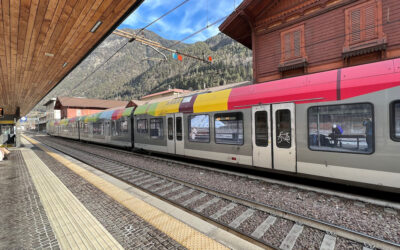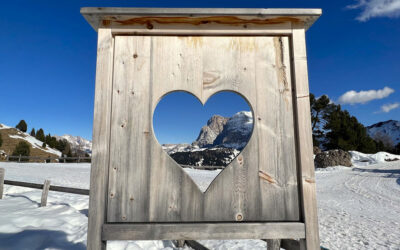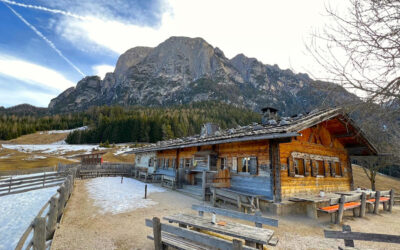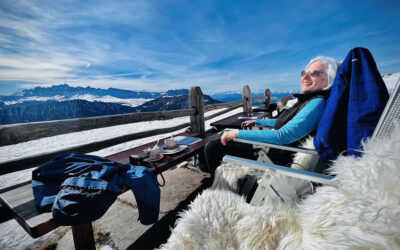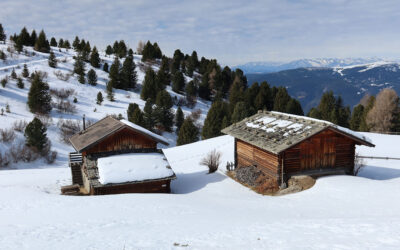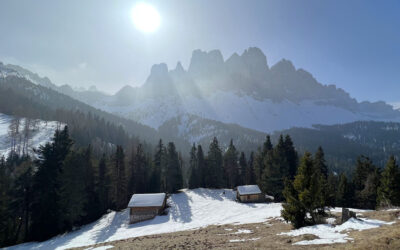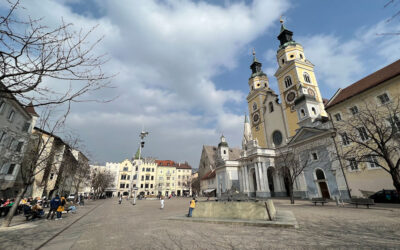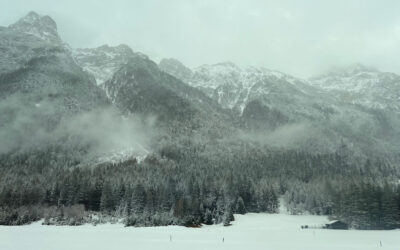Castelrotto
February 18 - 25, 2023
Exploring Castelrotto
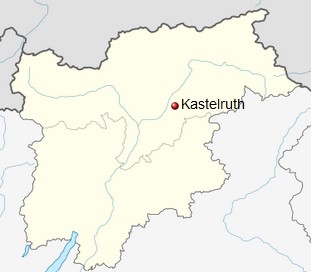 For the third week of our adventure in the Südtirol Cindy and I moved southwest to the small town of Castelrotto, also known as ‘Kastelruth’ in German. A Südtirolmobil local train took us from Innichen to Fortezza where we switched to a Trenitalia regional train south through Brixen to Ponte Gardena. Cindy had arranged for a car service to meet us at the Bahnhof in Ponte Gardena for the final leg up to Castelrotto. We could have taken a bus, but the taxi was better in terms of scheduling and easier in terms of baggage handling, plus they dropped us directly at the front door of our apartment building. This might seem like a splurge, but using taxis this way is actually very reasonable in terms of cost and we’ve found them to be quite professional. We wouldn’t do it every day, but it does make relocation days much easier.
For the third week of our adventure in the Südtirol Cindy and I moved southwest to the small town of Castelrotto, also known as ‘Kastelruth’ in German. A Südtirolmobil local train took us from Innichen to Fortezza where we switched to a Trenitalia regional train south through Brixen to Ponte Gardena. Cindy had arranged for a car service to meet us at the Bahnhof in Ponte Gardena for the final leg up to Castelrotto. We could have taken a bus, but the taxi was better in terms of scheduling and easier in terms of baggage handling, plus they dropped us directly at the front door of our apartment building. This might seem like a splurge, but using taxis this way is actually very reasonable in terms of cost and we’ve found them to be quite professional. We wouldn’t do it every day, but it does make relocation days much easier.
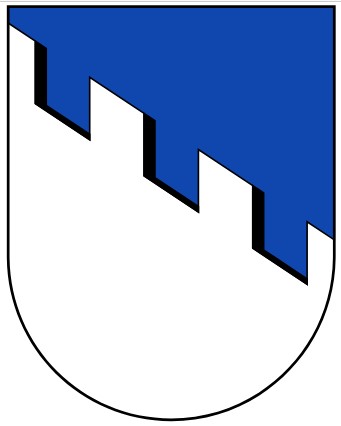 Castelrotto has a population of about 7,000 people so it’s big enough to meet our travel needs with a variety of lodging, good bus access, and a decent grocery store. Records of settlement date back to the 900’s so there’s quite a bit of history in the area. In fact the rather unusual name is a derivation of ‘Castilrut’ which translates to “ruined castle”.
Castelrotto has a population of about 7,000 people so it’s big enough to meet our travel needs with a variety of lodging, good bus access, and a decent grocery store. Records of settlement date back to the 900’s so there’s quite a bit of history in the area. In fact the rather unusual name is a derivation of ‘Castilrut’ which translates to “ruined castle”.
The town is perched in the mountains up above the Val Isarco and not far (only about 16 miles) from Bolzano, the region’s capital city. This proximity is a good thing in terms of accessing modern amenities, tranportation, cultural events, etc. But it’s also a bad thing as it makes the area a popular destination for daytrippers looking to make a quick mountain getaway. We’re planning our activities very carefully with this in mind as we really don’t like crowds. The good news is that by coordinating our adventures with the time of day and day of week we can minimize the crowd impact.
 Castelrotto’s iconic bell tower, located on the town square, stands 250 feet tall and is the tallest in the region. It truly dominates the town and is a useful landmark when exploring the area. The bells ring like clockwork on the hour from 6:00 AM to 10:00 PM, provide storm warnings, call people to mass, and sometimes ring for no particular reason (at least not that we could tell). The bottom line is that tourists staying anywhere near the town center should probably not expect to sleep in! No doubt the locals to the used to the ‘old school’ sonic timekeeping.
Castelrotto’s iconic bell tower, located on the town square, stands 250 feet tall and is the tallest in the region. It truly dominates the town and is a useful landmark when exploring the area. The bells ring like clockwork on the hour from 6:00 AM to 10:00 PM, provide storm warnings, call people to mass, and sometimes ring for no particular reason (at least not that we could tell). The bottom line is that tourists staying anywhere near the town center should probably not expect to sleep in! No doubt the locals to the used to the ‘old school’ sonic timekeeping.
As with most of the Südtirol region, Castelrotto is officially tri-lingual. According to the 2011 census, roughly 81% of the population speaks German, 15% speaks the ethnic Ladin, and 4% speaks Italian as their first language. For this reason it’s easy to guess that the town is decidedly much more Germanic than Italian in terms of architecture, food, and traditions. It’s very easy to forget that you’re in the mountains of Italy when you’re wandering around town, shopping, or listening to the locals. All that said, if you venture much further south than Castelrotto (to Bolzano, for example) the travel experience suddenly becomes much more Italian.
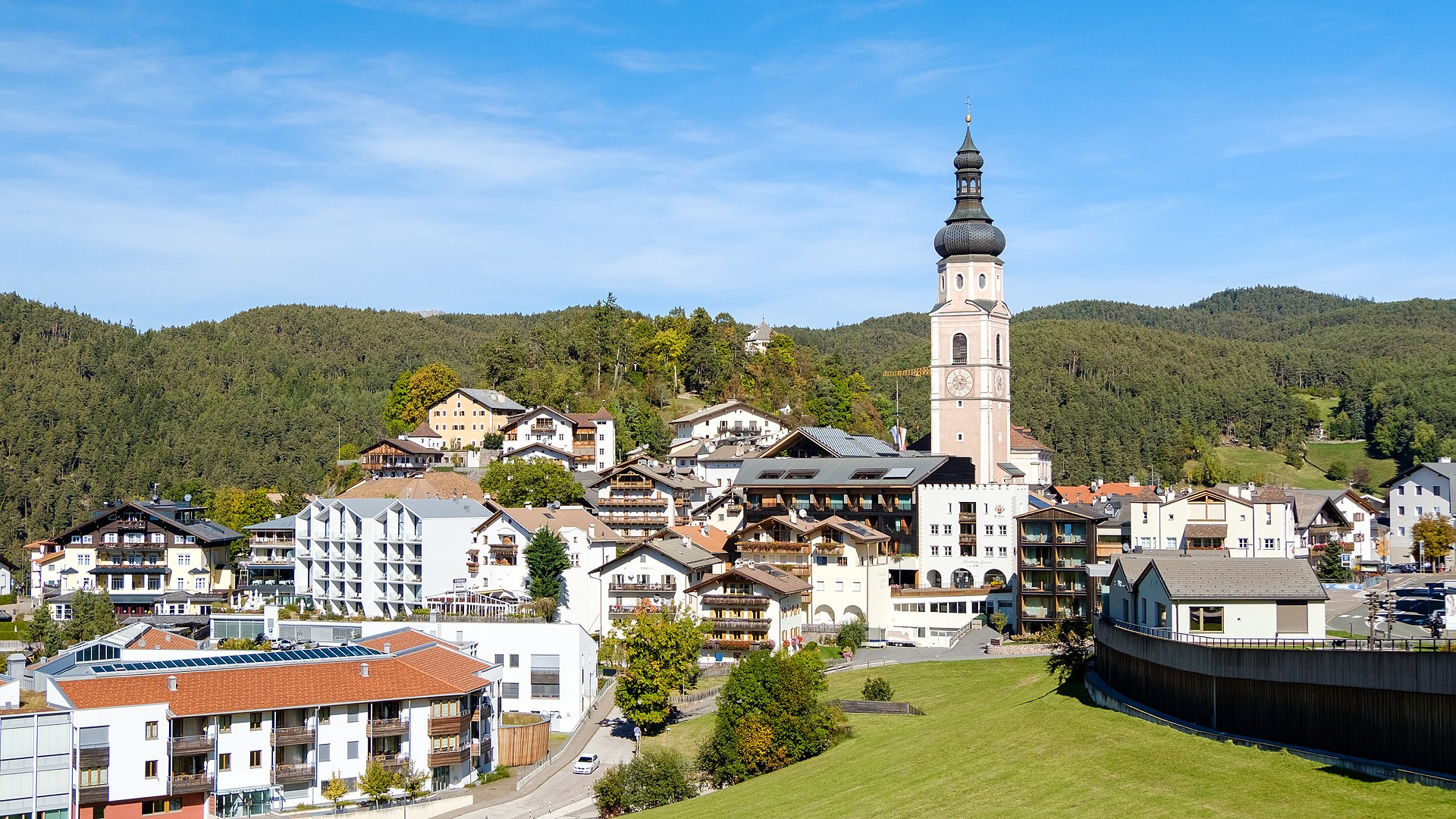 Castelrotto is one of the two major gateway towns to the Alpe di Siusi – the other being Ortisei, a town we explored for a memorable week in early October of 2022. The Alpe di Siusi (‘Seiser Alm’ in German)is the largest high-altitude alpine meadow in Europe, but calling it a meadow is somewhat misleading because this high altitude expanse of rolling, grass-covered terrain covers roughly 34 square miles! The area is popular with hikers and bicyclists in the summer. Downhill skiing, cross-country skiing, sledding, and winter hiking make it a busy place in the winter as well, but whatever the season it quiets down rapidly as you get away from the core.
Castelrotto is one of the two major gateway towns to the Alpe di Siusi – the other being Ortisei, a town we explored for a memorable week in early October of 2022. The Alpe di Siusi (‘Seiser Alm’ in German)is the largest high-altitude alpine meadow in Europe, but calling it a meadow is somewhat misleading because this high altitude expanse of rolling, grass-covered terrain covers roughly 34 square miles! The area is popular with hikers and bicyclists in the summer. Downhill skiing, cross-country skiing, sledding, and winter hiking make it a busy place in the winter as well, but whatever the season it quiets down rapidly as you get away from the core.
The activities for our week in Castelrotto centered around the Alpe di Siusi with multiple hikes on the plateau that featured the requisite (and typically excellent) hütte lunches. We became quite familiar with the quick 10 minute bus ride to the neighboring town of Seis where we boarded the Seiser Alm Bahn, a cable car that would took us up to Compatsch. This resort center served as the starting point for all of our hikes on the Alpe di Siusi – the Sanon Hütte, the Mahlknecht Hütte, the Tuff Alm, and the Arnika Hütte.
We also went a bit further afield from our base in Castelrotto for adventure days in the nearby Val Gardena, the Val di Funes, and Brixen. The wonderful Resciesa ridge forms the northern rim of the nearby Val Gardena and offers some of the best views in the area – it tends to fly under the radar in terms of crowds so it’s one of our favorite hikes in the Dolomites. The Val di Funes is one valley north of the Val Gardena. In areas it’s been victimized by Instagram but we managed to hike well beyond the usual range of the day-trippers and found a quiet spot to enjoy a scenic lunch high in the mountains. And our final outing to Brixen felt almost like returning home as we had spent two weeks there during our extended trip in the Fall of 2022. We immediately knew our way around and could visit favorite spots (and favorite restaurants!) without needing to consult any kind of map or guide.
Overall our visit to Castelrotto did not disappoint. As expected it served as an excellent gateway to this part of the Dolomites. It had good transport connections, nice lodging, good restaurants, and nice scenery without being crowded. It was definitely more of a town than a city and wasn’t overly biased towards tourists, so all-in-all we’d definitely consider a return trip at some point in the future.
Our Blog For Castelrotto
Day 14 – Our Move To Castelrotto
On Saturday Cindy and I relocated to Castelrotto, a quick train trip that took us about 60 miles southwest of Innichen.
Day 15 – Hike To Mahlknecht Hütte
Our destination for Sunday’s hike was the Mahlknecht Hütte, another of the family-run hüttes that we visited this trip.
Day 16 – Hike To The Tuff Alm
Today we hiked up to the Tuff Alm, a small inn high on a knoll and set in the shadow of the nearby Piccolo Sciliar.
Day 17 – The Cross On Resciesa
Today’s adventure was a hike along the Resciesa, a long ridgeline that forms much of the northern edge of Val Gardena.
Day 18 – A Circuit Of The Puflatsch
On Wednesday Cindy and I hiked a snowy trail around the Puflatsch, an elevated part of the Alpe di Siusi with great views.
Day 19 – A Hike To The Gampen Alm
We hike through a forest, across a large meadow, and then make a long climb up the Val di Funes to the Gampen Alm.
Day 20 – Back To Old Town Brixen
Today would be our last full day in Italy. We’d be lying if we said that we weren’t just a little tired of constant adventures!
Day 21 – A Night In Garmisch
On Saturday Cindy and I left Castelrotto and passed through Austria on our way to a snowy night in Garmisch, Germany.
Useful Links For Castelrotto
General Information :: Wikipedia
Weather :: weather.com
Official Website :: Marktgemeinde Kastelruth
Tourist Office :: Castelrotto.info
Travel Planning :: Trip Advisor
Lodging :: Airbnb / VRBO
Train Information :: Bahn.com / Trenitalia.com
Regional Transit Information :: Südtirolmobil

